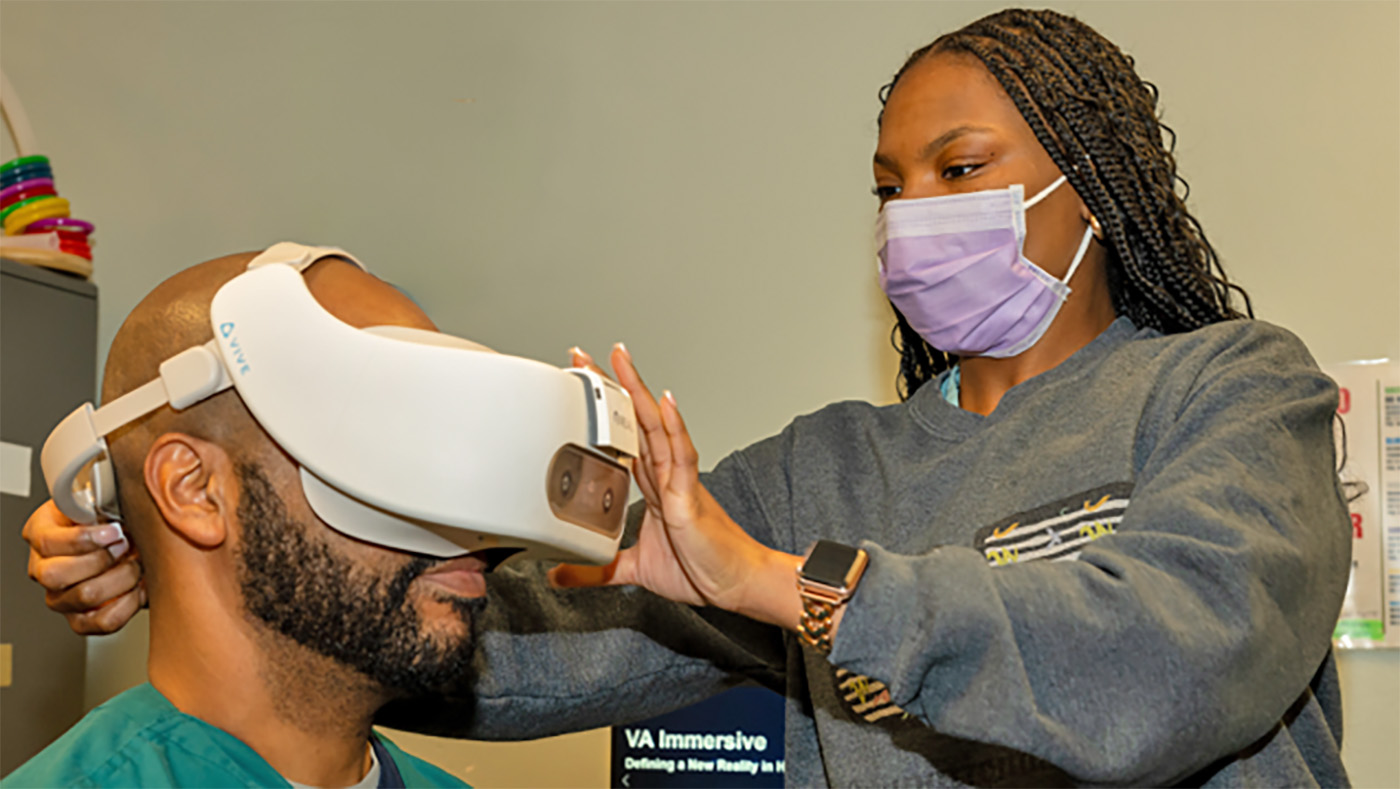At G. V. (Sonny) Montgomery VA in Jackson, Miss., new technology is profoundly impacting Veterans’ health care. Virtual reality (VR) is at the forefront of this revolution and it’s used to diminish pain and anxiety, and enhance rehabilitation in ways traditional methods have not.
Sierra Barnes, occupational therapy student, embarked on a significant project to develop and implement a VR protocol tailored for the acute care setting in occupational therapy (OT). During her presentation, Barnes showcased the transformative impact VR technology is having on patient care.
Under the mentorship of Kendrick Bankhead, Doctor of Occupational Therapy (OTD) Capstone mentor and the clinical education coordinator, she explained how VR is instrumental in improving patient experiences by alleviating pain, anxiety and insomnia during hospital stays. With Bankhead’s guidance, Barnes successfully crafted a protocol that is based on solid evidence and also practical and efficient for the acute OT staff to adopt.
Veterans undergo thorough screening
VR therapy is administered with care. Veterans interested in the therapy must undergo a thorough screening that evaluates their medical history and current health status. Exclusion criteria rule out candidates with conditions such as active psychosis, legal blindness, a recent history of seizures, active dizziness or nausea, or head, neck or facial injuries that would interfere with the use of VR headset
Once cleared, Veterans undergo a meticulous process where their vital signs are monitored before, during and after the VR sessions. These sessions might include virtual tours, outdoor retreats or guided relaxation exercises. Each session is conducted with the utmost care to ensure comfort and safety, and there are signs placed outside the treatment rooms to prevent interruptions.
Pictured above, Kendrick Bankhead, occupational therapist, and Sierra Barnes, OT student, test new virtual reality headsets.
Veterans report significant benefits
Many Veterans have shown improved vital signs post-VR treatment and reported significant benefits from their sessions in reducing their symptoms. Those who exhibited substantial benefits from VR usage were recommended for follow-up care with the outpatient OT clinic at the medical center.
Implementing VR in such a high-stakes environment faces challenges. High patient turnover, the physical layout of the hospital and the acuity of patients’ conditions can complicate the delivery of VR therapy. Nonetheless, many Veterans have reported significant improvements in their symptoms post-therapy, affirming the efficacy of the technology.
Barnes and Bankhead’s commitment to this innovative approach led them to apply for the VISN 16 Innovation Grant. They provided evidence-based literature, an action plan and a spending plan to support the funding of their project. They aim to expand the program with additional VR headsets and one Clean Box to continue benefiting Veterans. Approval of this grant is pending, but the potential for broader application remains high.
Disclaimer: The Occupational Therapy Department did not conduct any clinical research regarding virtual reality with Veterans. All VR devices were used with Veterans during routine acute occupational therapy sessions for VR protocol development only. VA OT staff and the Department of Veterans Affairs do not endorse or market any specific VR vendors, products or devices.
Topics in this story
Link Disclaimer
This page includes links to other websites outside our control and jurisdiction. VA is not responsible for the privacy practices or the content of non-VA Web sites. We encourage you to review the privacy policy or terms and conditions of those sites to fully understand what information is collected and how it is used.
More Stories
Study underscores important role COVID vaccination can have in protecting Veterans from infection and reducing long-term health consequences
Columbia VA’s robotic surgery teams completed their 800th robotic surgery and are on schedule to hit 1,000 by the end of the year.
In a decentralized clinical trial, Veterans can participate from their own homes or local VA instead of having to travel to a research site.






